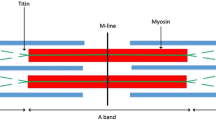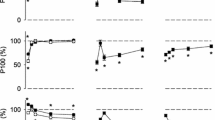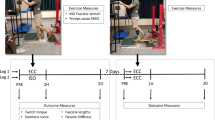Abstract
Eccentric exercise can produce damage to muscle fibres. Here damage indicators are measured in the medial gastrocnemius muscle of the anaesthetised cat after eccentric contractions on the descending limb of the muscle’s length-tension relation, compared with eccentric contractions on the ascending limb and concentric contractions on the descending limb. One damage indicator is a shift of the optimum length for peak active tension, in the direction of longer muscle lengths. The shift has been attributed to an increase in muscle compliance. It is a corollary of a current theory for the mechanism of the damage. With the intention of seeking further support for the theory, in these experiments we test the idea that other damage indicators, specifically the fall in twitch:tetanus ratio and in muscle force are due, in part, to such an increase in compliance. This was tested in an undamaged muscle by insertion of a compliant spring (0.19 mm N−1) in series with the muscle. This led to a fall in tetanic tension by 17%, a shift in optimum length of 1.7 mm in the direction of longer muscle lengths and a fall in twitch tetanus ratio by 15%. The fall in tension is postulated to be due to development of non-uniform sarcomere lengths within muscle fibres. It is concluded that after a series of eccentric contractions of a muscle, the fall in force is the result of a number of interdependent factors, not all of which are a direct consequence of the damage process.







Similar content being viewed by others
References
Allen DG (2001) Eccentric muscle damage: mechanisms of early reduction of force. Acta Physiol Scand 171:311–319
Allen DG, Whitehead NP, Yeung EW (2005) Mechanisms of stretch-induced muscle damage in normal and dystrophic muscle: role of ionic changes. J Physiol 567:723–735
Bowers EJ, Morgan DL, Proske U (2004) Damage to the human quadriceps muscle from eccentric exercise and the training effect. J Sports Sci 22:1005–1014
Brockett CL, Morgan DL, Proske U (2001) Human hamstring muscles adapt to eccentric exercise by changing optimum length. Med Sci Sports Ex 33:783–790
Brockett CL, Morgan DL, Gregory JE, Proske U (2002) Damage to different motor units from active lengthening of the medial gastrocnemius muscle of the cat. J Appl Physiol 92:1104–1110
Butterfield TA, Herzog W (2005) Is the force-length relationship a useful indicator of contractile element damage following eccentric exercise? J Biomech 38:1932–1937
Clarkson PM, Byrnes WC, McCormick KM, Turcotte LP, White JS (1986) Muscle soreness and serum creatine kinase activity following isometric, eccentric, and concentric exercise. Int J Sports Med 7:152–155
Close RI (1972) The relations between sarcomere length and characteristics of isometric twitch contractions of frog sartorius muscle. J Physiol 220:745–762
Faulkner JA, Brooks SV, Opiteck JA (1993) Injury to skeletal muscle fibres during contractions: conditions of occurence and prevention. Phys Ther 73:911–921
Gordon AM, Huxley AF, Julian FJ (1966) The variation in isometric tension with sarcomere length in vertebrate muscle. J Physiol 184:170–192
Jones DA, Newham DJ, Torgan C (1989) Mechanical influences on long-lasting human muscle fatigue and delayed onset pain. J Physiol 412:415–427
Jones C, Allen T, Talbot J, Morgan DL, Proske U (1997) Changes in the mechanical properties of human and amphibian muscle after eccentric exercise. Eur J Appl Physiol Occup Physiol 76:21–31
Julian FJ, Morgan DL (1979) The effect on tension of non-uniform distribution of length changes applied to frog muscle fibres. J Physiol 293:378–392
Lieber RL, Woodburn TM, Friden J (1991) Muscle damage induced by eccentric contractions of 25% strain. J Appl Physiol 70:2498–2507
MacIntyre DL, Reid WD, McKenzie DC (1995) Delayed muscle soreness. The inflammatory response to muscle injury and its clinical implications. J Sports Med 20:24–40
Morgan D, Proske U (2004) Popping sarcomere hypothesis explains stretch-induced muscle damage. Clin Exp Pharmacol Physiol 31:541–545
Morgan DL (1990) New insights into the behaviour of muscle during active lengthening. Biophys J 57:209–221
Morgan DL, Allen DG (1999) Early events in stretch-induced muscle damage. J Appl Physiol 87:2007–2115
Morgan DL, Whitehead NP, Wise AK, Gregory JE, Proske U (2000) Tension changes in the cat soleus muscle following slow stretch or shortening of the contracting muscle. J Physiol 522:503–513
Morgan DL, Gregory JE, Proske U (2004) The influence of fatigue on damage from eccentric contractions in the gastrocnemius muscle of the cat. J Physiol 561:841–850
Newham DJ, McPhail G, Mills KR, Edwards RHT. (1983a). Ultrastructural changes after concentric and eccentric contractions of human muscles. J Neurol Sci 61:109–122
Newham DJ, Mills KR, Quigley BM, Edwards RH. (1983b). Pain and fatigue after concentric and eccentric contractions of human muscle. Clin Sci (Lond) 64:55–62
Parikh S, Morgan DL, Gregory JE, Proske U (2004) Low-frequency depression of tension in the cat gastrocnemius muscle after eccentric exercise. J Appl Physiol 97:1195–1202
Proske U, Morgan DL (1984) Stiffness of cat soleus muscle and tendon during activation of part of muscle. J Neurophysiol 52:459–468
Proske U, Morgan DL (2001) Muscle damage from eccentric exercise: mechanism, mechanical signs, adaptation and clinical applications. J Physiol 537:333–345
Russ DW, Binder-Macleod SA (1999) Variable-frequency trains offset low-frequency fatigue in human skeletal muscle. Muscle Nerve 22:874–882
Takekura H, Fujinami N, Nishizawa T, Ogasawara H, Kasuga N (2001) Eccentric exercise-induced morphological changes in the membrane systems involved in excitation-contraction coupling in rat skeletal muscle. J Physiol 533:571–583
Talbot JA, Morgan DL (1998) The effects of stretch parameters on eccentric exercise-induced damage to toad skeletal muscle. J Muscle Res Cell Motil 19:237–245
Walmsley B, Proske U (1981) Comparison of stiffness of soleus and medial gastrocnemius muscles in cats. J Neurophysiol 46:250–259
Warren GL, Ingalls CP, Lowe DA, Armstrong RB (2001) Excitation–contraction uncoupling: major role in contraction-induced muscle injury. Exer Sport Sci Rev 29:82–87
Whitehead NP, Morgan DL, Gregory JE, Proske U (2003) Rises in whole muscle passive tension of mammalian muscle after eccentric contractions at different lengths. J Appl Physiol 95:1224–1234
Wood S, Morgan DL, Proske U (1993) Effects of repeated eccentric contractions on structure and mechanical properties of toad sartorius muscle. Am J Physiol 265:C792–C800
Acknowledgments
Financial support from the National Health and Medical Research Council of Australia is acknowledged.
Author information
Authors and Affiliations
Corresponding author
Rights and permissions
About this article
Cite this article
Gregory, J.E., Morgan, D.L., Allen, T.J. et al. The shift in muscle’s length-tension relation after exercise attributed to increased series compliance. Eur J Appl Physiol 99, 431–441 (2007). https://doi.org/10.1007/s00421-006-0363-x
Accepted:
Published:
Issue Date:
DOI: https://doi.org/10.1007/s00421-006-0363-x




